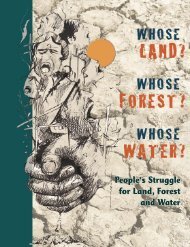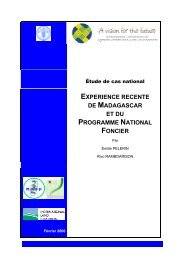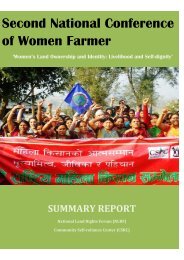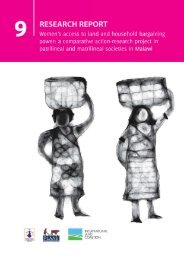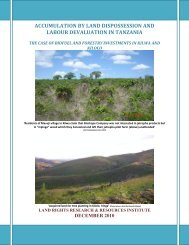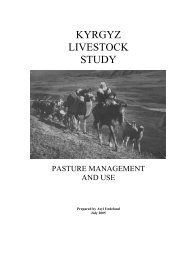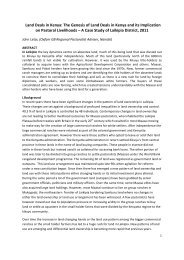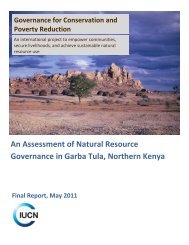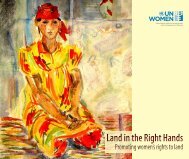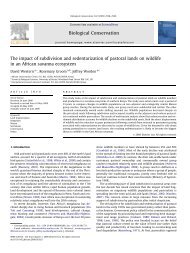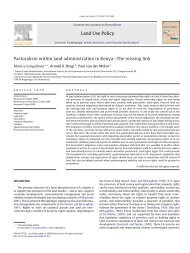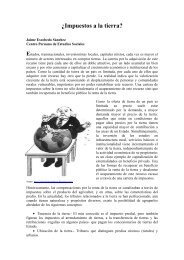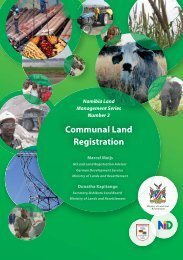Wildlife Management and Village Land Tenure in ... - Land Portal
Wildlife Management and Village Land Tenure in ... - Land Portal
Wildlife Management and Village Land Tenure in ... - Land Portal
You also want an ePaper? Increase the reach of your titles
YUMPU automatically turns print PDFs into web optimized ePapers that Google loves.
Introduction<br />
Northern Tanzania’s l<strong>and</strong>scape is characterized by extensive semi-arid rangel<strong>and</strong>s where<br />
rural communities, mostly pastoralists or agro-pastoralists, use large tracts of l<strong>and</strong>s <strong>and</strong><br />
widely distributed resources <strong>in</strong> a climatically unpredictable environment. Secur<strong>in</strong>g<br />
access to the l<strong>and</strong> base which such livelihoods depend on <strong>in</strong> these savannah rangel<strong>and</strong>s is<br />
critical for these people, <strong>and</strong> has been the central socioeconomic <strong>and</strong> political issue <strong>in</strong><br />
northern Tanzania dur<strong>in</strong>g much of the past twenty years.<br />
Northern Tanzania’s communities share their environment with some of the most<br />
substantial rema<strong>in</strong><strong>in</strong>g populations of wild animals rema<strong>in</strong><strong>in</strong>g <strong>in</strong> the world. This wildlife<br />
is the subject of long-st<strong>and</strong><strong>in</strong>g conservation efforts <strong>and</strong> is the basis of a tourism <strong>in</strong>dustry<br />
valued at around 10% of Tanzania’s national GDP (World Bank/MIGA 2002). The<br />
<strong>in</strong>teraction between wildlife management on the one h<strong>and</strong>, <strong>and</strong> rural l<strong>and</strong> tenure, on the<br />
other, is a complex one. On the one h<strong>and</strong>, much of the wildlife <strong>in</strong> northern Tanzania<br />
rema<strong>in</strong>s widely dispersed across the region’s rangel<strong>and</strong>s because of the traditional coexistence<br />
of pastoralist l<strong>and</strong> use practices with wildlife (Collet, 1987; Homewood <strong>and</strong><br />
Rodgers, 1991; Boone <strong>and</strong> Coughenour, 2001). But at the same time, the establishment<br />
of state protected areas for wildlife <strong>and</strong> tourism has been a major cause of local l<strong>and</strong> loss<br />
<strong>and</strong> alienation <strong>in</strong> northern Tanzania dur<strong>in</strong>g the past fifty years (Parkipuny, 1991;<br />
Neumann, 1998; Igoe <strong>and</strong> Brock<strong>in</strong>gton, 1999).<br />
Today the tensions between wildlife management <strong>and</strong> village l<strong>and</strong> tenure cont<strong>in</strong>ue, albeit<br />
with new nuances, legal issues, <strong>and</strong> contest<strong>in</strong>g parties over access to l<strong>and</strong>s <strong>and</strong> resources.<br />
The focus of local l<strong>and</strong> tenure contests has shifted from the core state protected areas- the<br />
National Parks <strong>and</strong> Game Reserves- which <strong>in</strong> most cases were removed from local<br />
control decades ago, to the village l<strong>and</strong>s themselves. The issue is no longer the black<strong>and</strong>-white<br />
one of evict<strong>in</strong>g local people <strong>and</strong> establish<strong>in</strong>g exclusive parks, but centers<br />
around numerous local contests over degrees of control of access <strong>and</strong> rights to l<strong>and</strong> <strong>and</strong><br />
wildlife.<br />
This paper explores <strong>and</strong> analyzes these contemporary contests over l<strong>and</strong> tenure <strong>in</strong><br />
northern Tanzania’s village l<strong>and</strong>s as they relate to wildlife management <strong>and</strong> l<strong>and</strong> policy<br />
<strong>and</strong> legislation. It details the nature of the contests <strong>and</strong> conflicts, <strong>in</strong>clud<strong>in</strong>g their legal<br />
aspects, <strong>and</strong> further seeks to diagnose the underly<strong>in</strong>g political economic reasons beh<strong>in</strong>d<br />
these endemic conflicts. It concludes by relat<strong>in</strong>g these underly<strong>in</strong>g issues to the broader<br />
macroeconomic environment <strong>and</strong> efforts to improve the security of local l<strong>and</strong> tenure <strong>in</strong><br />
the region for both livelihood <strong>and</strong> environmental concerns.<br />
Background: Rural L<strong>and</strong> <strong>Tenure</strong> <strong>and</strong> <strong>Wildlife</strong> <strong>Management</strong> <strong>in</strong> Northern Tanzania<br />
Interactions between wildlife management <strong>and</strong> local l<strong>and</strong> rights <strong>in</strong> northern Tanzania can<br />
be traced back to the colonial period. Initial wildlife laws <strong>and</strong> regulations passed by the<br />
German colonial regime <strong>in</strong> the 1890’s <strong>and</strong> early 1900’s focused primarily on restrict<strong>in</strong>g<br />
the use of wildlife (kill<strong>in</strong>g animals), <strong>and</strong> where reserves were set up with conservation<br />
purposes <strong>in</strong> m<strong>in</strong>d the rights of local people to live <strong>in</strong> <strong>and</strong> use them were reta<strong>in</strong>ed. It was<br />
2




